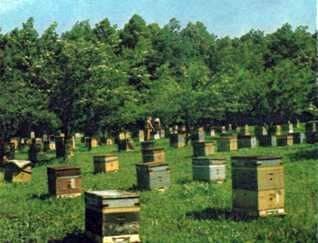Methods of orienting bees

We are facing a large beekeeping pavilion. Twenty bee colonies are located nearby, and all hives look exactly alike. Thousands of worker bees are fleeing for a bribe; with the rapidity of arrows, buzzing, they are carried away. Returning bees confidently and without the slightest hesitation fly up to their native hive and disappear in its taphole. We catch the bee, which is just trying to get home, mark it with a colored dot, and, enclosing it in a small box, take us about half an hour’s walk from the hive, where we will release to freedom. One observer remains near the hives and informs us that the marked bee returned home a few minutes after we restored her freedom.
There were attempts to explain all this by the action of some “magnetic” force, which in kilometers confidently directs the bee to its native hive. But with a more careful study, it ceases to seem something like magic.
A young bee who does the work of a wet nurse and has never left a hive will not find her home, even if we take her only 50 meters from him and release him. First she needs to get acquainted with the terrain, and this happens when she reaches the age of ten, making her first flight. The flight lasts about six minutes, but not for the purpose of visiting flowers or other sources of a bribe, but solely for the sake of acquaintance with the situation of the hive and the surrounding area. The bees are very agile. They need only two minutes to fly one kilometer. And they are very attentive during the orientation flight. If they are caught after a single departure and then released somewhere in the same area, many of them return home even from a distance of several hundred meters.
The first orienting circling is followed by other, increasingly distant, and thus the bees soon master the entire zone of their summer, which can extend for several kilometers in all directions. But even old bee pickers,
There is one more circumstance that is too well coordinated with our own experience, so that it is possible to admit the existence of some mysterious force directing the bees to their dwelling: they very often go astray! How frequent are such cases when still insufficiently oriented bees do not find their own beehive and perish at will, we do not know this. But it is well known that in a large pavilion, all the hives are similar to each other, they often fly into a strange hive. Making sure of this is very simple. We will open a hive and mark with white dots several hundreds of bees there. After a few days we will see that many bees with a white label are also flying out of neighboring hives and even from hives located entirely at the other end of the pavilion and fly back into them.
Beekeepers are familiar with this phenomenon. It is extremely undesirable, because the guardian bees do not always freely pass into the beehive of foreign bees, which they recognize by smell. Often, the meeting at the tap is ended in a fight with a sting, and this leads to the death of some bees or at least to the loss of time. Each beekeeper would prefer that it be spent on collecting honey. But it is especially unpleasant if the uterus, returning from the voyage, will confuse its beehive with a stranger. For her, this is a sure death, and her whole family will be doomed to death, unless the bees can get another womb.
That is why many beekeepers have long been painting the front walls of hives in different colors to help bees recognize their home and not to confuse it with neighboring hives. True, opinions on the practical usefulness of this measure disagreed, and as a result, it was not used everywhere. Now it is known that the coloring of the hive is an excellent way to prevent bee flying into other people’s homes. It is also clear why this means was so often doubted: the colors that were meant for bee eyes were chosen by the eyes of the person. When the beekeeper placed nearby yellow, green and orange hives or red sticks next to black, then, of course, he could not succeed, because the bees seem to be similar or even identical to the bees.
Methods of orienting bees

